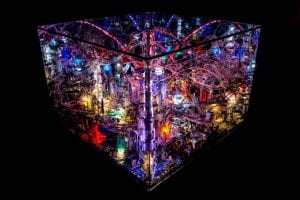Recycling Future or Free Painting
By Lisa J Walters, on 19 October 2017
Oskar OK Krajewski, Polish Artist in London, on art, recycling, and migration
Dr Urszula Chowaniec, Senior Teaching Fellow in Polish Language
Thousands of small objects… hundreds of fragments linked together in a seemingly random way create an ideal shape; a colourful space interlaced with light and flickering glimpses, as if just for this sculptured form all the tiny items were intended. Was it only by accident or misunderstanding that they used to be a piece of computer, toy, or TV remote? They really meant to be Recycled Future.
Recycled Future is Oskar OK Krajewski’s centre sculpture presented during his exhibition at Oxo show (1-5 November, 2017). It is an amazing piece made of over 25,000 parts of old broken everyday objects. As a central piece, the whole exhibition is called Recycled Future. OK admits that this piece is representative to all his recent artworks. It took Oskar about 5 years to complete the whole show. He never works on one project at the time, rather he distracts himself over many works, and therefore it gets slower to complete the piece. But this is how ‘OK’ creates.
Recycled Future is a set of sculptures and photographs to be presented at the very beginning of November at the Oxo Tower Gallery. All the works are made of recycled materials. We live in a world where rubbish and trash material is everywhere and we tend to think about them as useless, with a need to be taken away. Oskar’s main intention is raising awareness of what can be done with rubbish. Oskar wishes to inspire other artists and show the way to ‘free paint’ as he calls the non-biodegradable waste around us. OK passionately explains his elaborate works composed from thousands of little pieces and which take the viewer into an amazing visual, aesthetic experience:
“Conceptual art, in my opinion, can be quite often too symbolic with very little eye-pleasing factor to it. Speaking to people about the environmental issue through my art is important, but choosing complex (physical) form is necessary for me. It flows from my centre (heart) and it has been like that since I remember. With time, my creations became denser and more elaborate. I’m always looking for perfection, yet I know it is impossible to catch it. It has a spiral shape going in both directions. Chasing perfection is nothing else but moving upwards on that spiral. The further up you go, the tighter and tinier it becomes, but never really disappears. I choose to use the spiral as a metaphor for my work, going deeper and deeper with the amount of detail. My art seems to be different every time you look at it. I use light and movement, therefore, it can bring out various values and messages for each individual viewer. We are all unique after all, pieced together by life experiences and set of genes…”
His sculptures highlight the important message of sustainability. The works are constructed from virtually anything not easily biodegradable that we casually throw away: obsolete computers, broken everyday objects, unwanted toys and all forms of plastic. He says that we are all brought to life with new meaning and beauty. His sculptures employ the latest technologies; sensors, light, sound and movement.
When asked about his main motives to create the exhibition that connects art with environmental issues, Oskar says: “I believe that in the near future we will grow up to the conclusion of reusing everything we have produced so far.
I had a dream once (some 20 years ago!) in which I have seen a rubbish mine. Now this concept came to life in the USA and companies are digging for metals in old landfills.”
A few years ago, Krajewski took part in the Polish migrants discussions during the Festival of the Arts at UCL. He talked about his story of emigrating. As a young student of Academy of Fine Art in Łódź, he came to London in Summer 2002 to make some money to buy a computer; necessary equipment for the architecture student. He never came back. London became his home, his space of artistic expression. He doesn’t see the impact of Poland, or his nationality in his art.
“On the other hand – says Oskar – I know that everything has an impact on you subconsciously. I had some hard times as a boy caused by my raging, booze driven father. At that point I kept portraying hell and its inhabitants, while I was scared and locked away in my room. I have always loved science and nature, so perhaps those two factors made me want to participate in saving our planet. I feel that one day, I may do something really good through art.”
Oskar OK Krajewski is a visual artist and has been exploring many types of media. Starting from drawings, painting and photography., he currently focuses his energy on sculpting. Oskar has freelanced for names such as StormStudios and Damien Hirst.
He has had 4 solo shows in England and abroad, with many more group shows and art fairs in London. His work was featured at the London’s iconic Gherkin for 6 months (Searcys Bar & Restaurant on the top floor), has been a selected artist by the Barcroft TV, is a member of LoVArts (London Visual Artists) and has collaborated with the charity Action For Children.
See also:
 Close
Close



